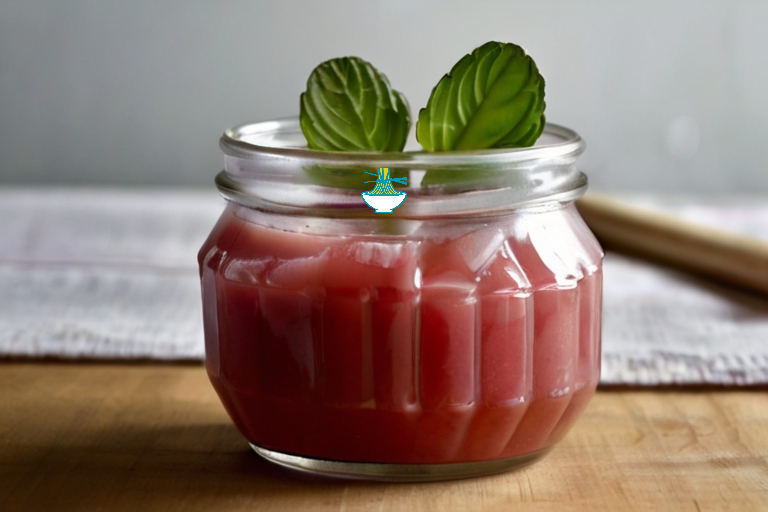Indulge in a taste of Danish tradition with Rabarbergrød, a beloved dessert that captures the essence of Denmark's culinary heritage. Translating to "rhubarb pudding," this delightful treat combines the tartness of fresh rhubarb with the sweetness of sugar, resulting in a luscious and comforting pudding-like consistency. Served warm or cold, Rabarbergrød is a versatile dish enjoyed throughout the year, but particularly cherished during the spring and summer months when rhubarb is in season. Whether enjoyed as a cozy family dessert or a refreshing summertime delight, Rabarbergrød encapsulates the simplicity and warmth of Danish cuisine, inviting you to savor each spoonful of its vibrant flavors.
Ingredients:
- 500g fresh rhubarb, trimmed and chopped into 1-inch pieces
- 150g granulated sugar (adjust according to taste and tartness of rhubarb)
- 100ml water
- 1 teaspoon vanilla extract
- Zest of 1 lemon (optional)
- Heavy cream or milk, for serving

Instructions:
Prepare the Rhubarb:
1- Wash the rhubarb stalks thoroughly under cold water and pat them dry with a clean kitchen towel.
2- Trim off any leaves and the tough ends of the stalks.
3- Chop the rhubarb into 1-inch pieces.
Cook the Rhubarb:
1- In a medium-sized saucepan, combine the chopped rhubarb, granulated sugar, water, vanilla extract, and lemon zest (if using).
2- Place the saucepan over medium heat and bring the mixture to a gentle simmer.
3- Stir occasionally to ensure the sugar is dissolved and evenly distributed.
Simmer the Compote:
1- Once the mixture begins to simmer, reduce the heat to low and let it cook gently.
2- Allow the rhubarb to soften and break down, stirring occasionally to prevent sticking.
3- Cook until the rhubarb is completely tender and the mixture has thickened slightly, about 15-20 minutes.
Adjust the Sweetness:
1- Taste the compote and adjust the sweetness if necessary by adding more sugar, a little at a time, until it reaches your desired level of sweetness.
2- Keep in mind that rhubarb can vary in tartness, so adjust accordingly.
Serve:
1- Once the compote has reached the desired consistency and sweetness, remove it from the heat and let it cool slightly.
2- Serve the Rabarbergrød warm or chilled, depending on your preference.
3- Traditionally, Rabarbergrød is served with a generous drizzle of heavy cream or milk on top.
4- Enjoy the vibrant flavors of this classic Danish dessert!
Storage:
1- Leftover Rabarbergrød can be stored in an airtight container in the refrigerator for up to a week. Simply reheat gently before serving, if desired.
Indulge in the simple pleasures of Danish cuisine with this delightful Rhubarb Compote, perfect for a cozy dessert or a refreshing treat on a warm day.
Nutritional Values:
Here are the approximate nutritional values for the ingredients used in the Rabarbergrød recipe:
Fresh Rhubarb (500g):
- Calories: 100
- Carbohydrates: 22g
- Fiber: 6g
- Protein: 2g
- Fat: 0g
- Vitamin C: 30% of the Daily Value (DV)
- Calcium: 10% of the DV
- Potassium: 12% of the DV
benefits:
- Rhubarb is low in calories and rich in fiber, making it beneficial for digestive health.
- It contains vitamin C, which supports immune function and promotes healthy skin.
- Rhubarb also provides calcium and potassium, important minerals for bone health and electrolyte balance.
Granulated Sugar (150g):
- Calories: 600
- Carbohydrates: 150g
- Fat: 0g
- Protein: 0g
benefits:
- While granulated sugar is high in calories and should be consumed in moderation, it provides a quick source of energy.
- In this recipe, sugar helps to sweeten the tartness of the rhubarb, enhancing its flavor.
Water (100ml):
- Calories: 0
- Fat: 0g
- Carbohydrates: 0g
- Protein: 0g
benefits:
- Water is essential for hydration and helps to maintain proper bodily functions.
- In the recipe, water is used to create the liquid base for cooking the rhubarb, aiding in the process of softening and breaking down the stalks.
Vanilla Extract (1 teaspoon):
- Calories: 12
- Carbohydrates: 0.6g
- Fat: 0g
- Protein: 0g
benefits:
- Vanilla extract adds flavor and aroma to the dish, enhancing its overall taste.
- While it is not a significant source of nutrients, vanilla extract can contribute to the sensory experience of the dessert.
Zest of 1 Lemon (optional):
- Calories: 3
- Carbohydrates: 1g
- Fiber: 0.5g
- Fat: 0g
- Protein: 0g
benefits:
- Lemon zest adds a bright, citrusy flavor to the compote, balancing the sweetness of the rhubarb.
- It contains antioxidants and vitamin C, which have potential health benefits, including immune support and skin health.
Heavy Cream (for serving):
- Nutrition values will vary depending on the amount used. Generally, heavy cream is high in calories, fat, and saturated fat.
benefits:
- Heavy cream is rich in fat and calories, providing energy and satiety.
- It also adds creaminess and richness to the dessert, enhancing its texture and flavor.
Milk (for serving):
- Nutrition values will vary depending on the type of milk (whole, skim, etc.) and the amount used. Generally, milk contains calories, carbohydrates, protein, calcium, and other nutrients.
benefits:
- Milk is a good source of calcium and vitamin D, which are important for bone health.
- It also provides protein, essential for muscle growth and repair, as well as other nutrients like vitamin B12 and potassium.
Please note that these values are approximate and may vary based on factors such as brand, variety, and preparation methods. Additionally, the nutritional values for heavy cream or milk will depend on the serving size and type chosen.


Comments